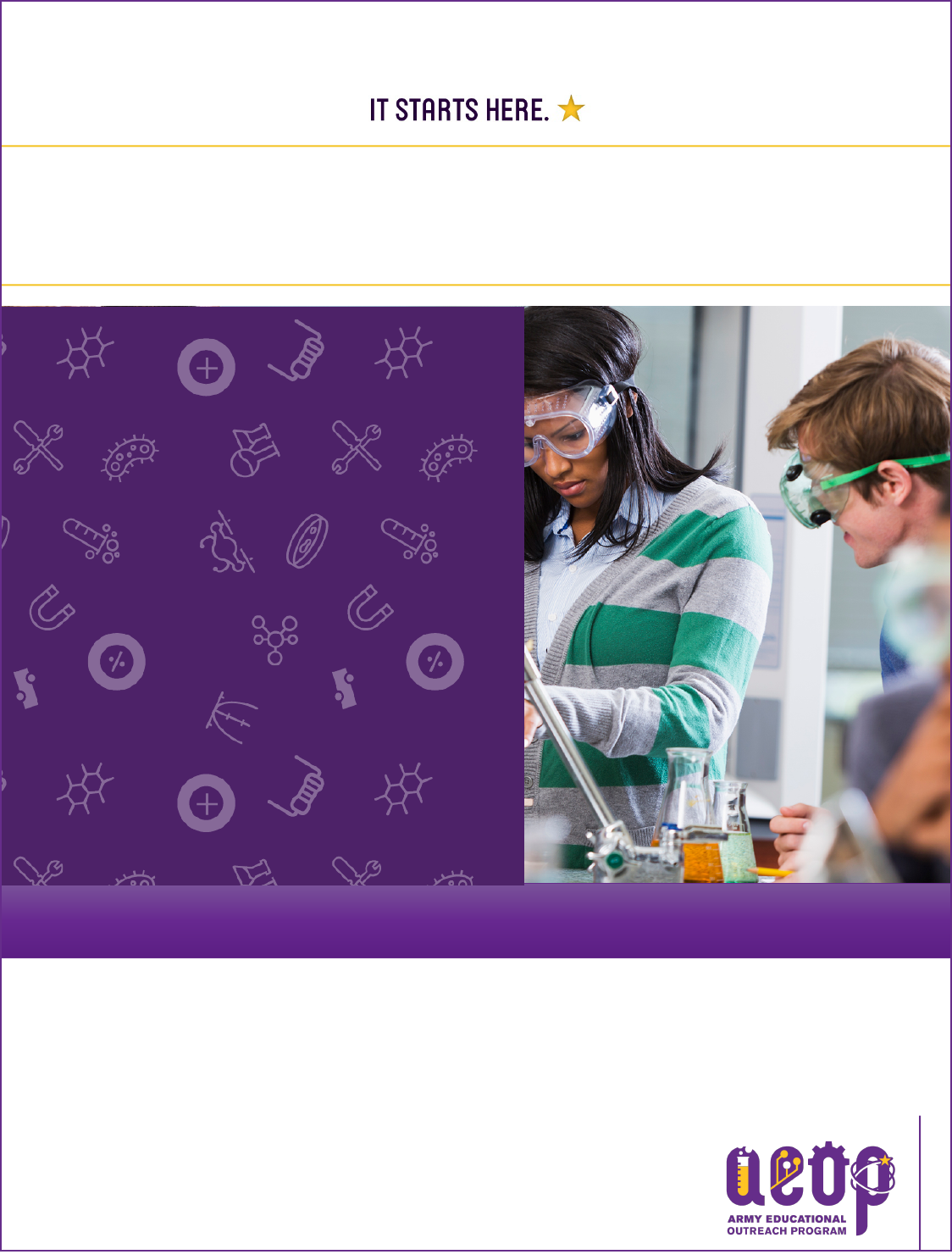
08
Fall
Army Educational Outreach Program
2017 Summative Evaluation Report
PART 1: Executive Summary
May 2018
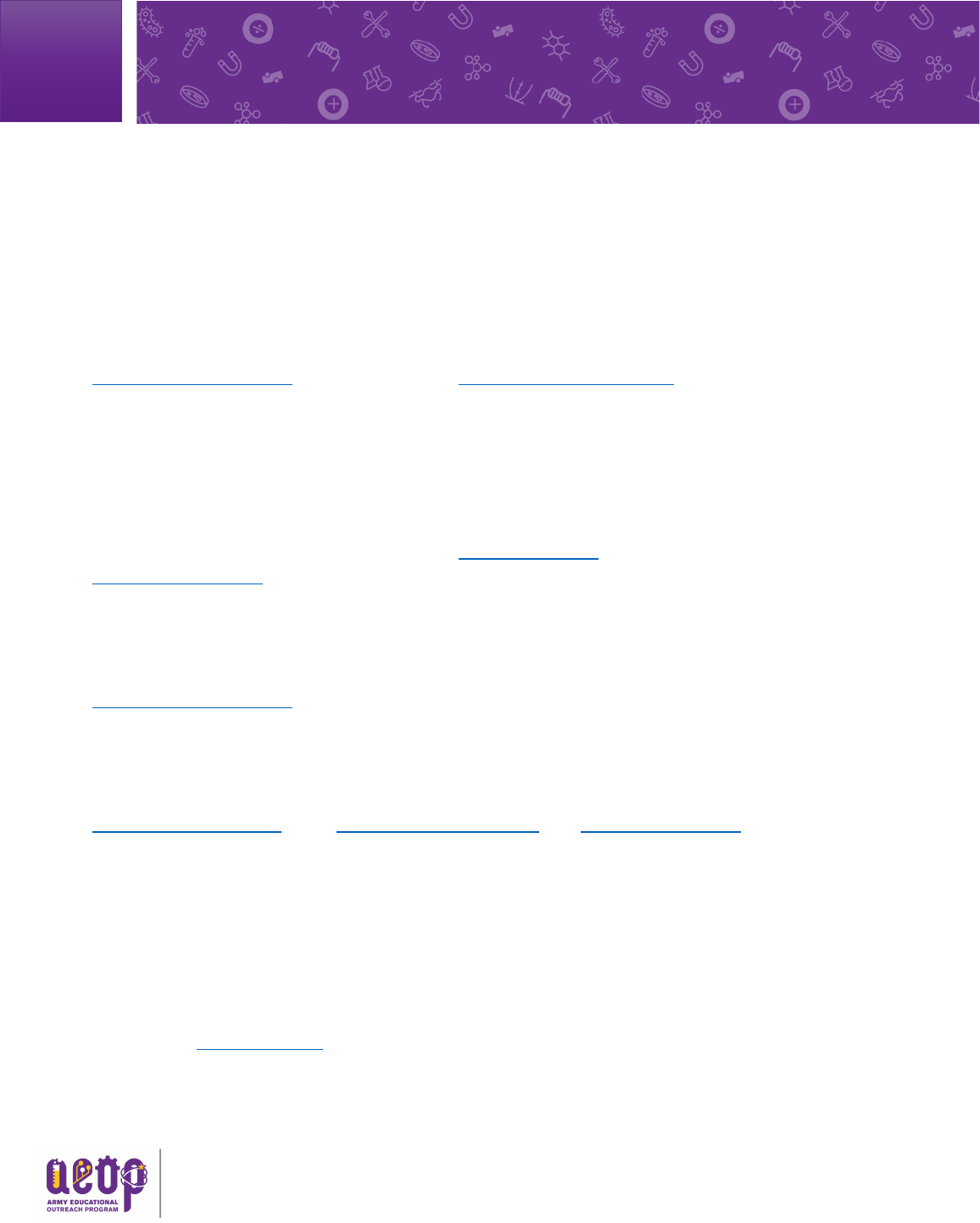
2017 Summative Evaluation Report | PART 1 Executive Summary | 1 |
1 | AEOP Consortium Contacts
U.S. Army Contacts
Matthew Willis, Ph.D. Andrea Simmons
Director, Laboratory Management Army Educational Outreach Program (AEOP) Director
Office of the Assistant Secretary of the Army Office of the Assistant Secretary of the Army
Acquisition, Logistics, and Technology Acquisition, Logistics, and Technology
matthew.p.willis.civ@mail.mil andrea.e.simmons.ctr@mail.mil
AEOP Cooperative Agreement Manager Battelle Memorial Institute – Lead Organization
Louie Lopez David Burns
AEOP Cooperative Agreement Manager (CAM) Project Director, AEOP CA
U.S. Army Research, Development, and Director of STEM Innovation Networks
Engineering Command (RDECOM) burnsd@battelle.org
louie.r.lopez.civ@mail.mil
Christina Weber
AEOP Deputy CAM
U.S. Army RDECOM
Evaluation Team Contacts – Purdue University
Carla C. Johnson, Ed.D. Toni A. Sondergeld, Ph.D. Janet B. Walton, Ph.D.
Evaluation Director, AEOP CA Assistant Director, AEOP CA Assistant Director, AEOP CA
carlacjohnson@purdue.edu tonisondergeld@metriks.com walton25@purdue.edu
Report AEOP_08_05232018 has been prepared for the AEOP Cooperative Agreement and the U.S. Army by Purdue
University College of Education on behalf of Battelle Memorial Institute (Lead Organization) under award W911 SR-15-
2-0001.
Full versions of the FY17 portfolio evaluation reports as well as individual program evaluation reports are available on
AEOP website: www.usaeop.com (About > Our Impact).
1

2017 Summative Evaluation Report | PART 1 Executive Summary | 2 |
2 | Table of Contents
AEOP Consortium Contacts Page 1
Table of Contents Page 2
Introduction Page 3
Summary of Findings and Recommendations Page 7
2

2017 Summative Evaluation Report | PART 1 Executive Summary | 3 |
3 | Introduction
The Army Educational Outreach Program (AEOP) vision is to offer a
collaborative and cohesive portfolio of Army sponsored science,
technology, engineering and mathematics (STEM) programs that
effectively engage, inspire, and attract the next generation of STEM
talent through K-undergraduate programs and expose them to
Department of Defense (DoD) STEM careers. The consortium, formed
by the Army Educational Outreach Program Cooperative Agreement
(AEOP CA), supports the AEOP in this mission by engaging non-profit,
industry, and academic partners with aligned interests, providing a
management structure that collectively markets the portfolio among
members, leveraging available resources, and providing expertise to
ensure the programs provide the greatest return on investment in
achieving the Army’s STEM priorities and objectives toward a STEM
literate citizenry, STEM savvy educators, and sustainable
infrastructure.
In FY17, the AEOP central application tool included 41,553 unique program participants, 32,947 were
youth program participants and 8,714 were adult participants. Adult participants included Army Scientists
and Engineers (S&Es) in various roles, such as mentors, judges, and presenters, as well as teachers
participating in the new RESET program. Of the total participants in 2017, 855 students and 40 teachers
were from 46 DoDEA schools from the Pacific, Europe and the U.S. The number of unique youth program
participants in 2017 (32,947) represented an increase from 2016 (30,973), but was still lower than in 2015
(38,039).
2017 AEOP Participation by Youth and Adults
Youth
Adults
CII
Camp Invention Initiative
1,425
112
CQL
College Qualified Leaders
229
206
eCM
eCYBERMISSION
21,277
3,253
GEMS
Gains in the Education of Mathematics & Science
2,845
510
HSAP
High School Apprenticeship Program
54
40
JSHS
Junior Science & Humanities Symposium
5,577
3,555
JSS
Junior Solar Sprint
892
327
REAP
Research & Engineering Apprenticeship Program
118
118
RESET
Research Experiences for STEM Educators and Teachers
NA
20
SEAP
Science & Engineering Apprentice Program
113
119
3
AEOP Priorities
Goal 1: STEM Literate Citizenry.
Broaden, deepen, and diversify the
pool of STEM talent in support of
our defense industry base.
Goal 2: STEM Savvy Educators.
Support and empower educators
with unique Army research and
technology resources.
Goal 3: Sustainable Infrastructure.
Develop and implement a cohesive,
coordinated, and sustainable STEM
education outreach infrastructure
across the Army.
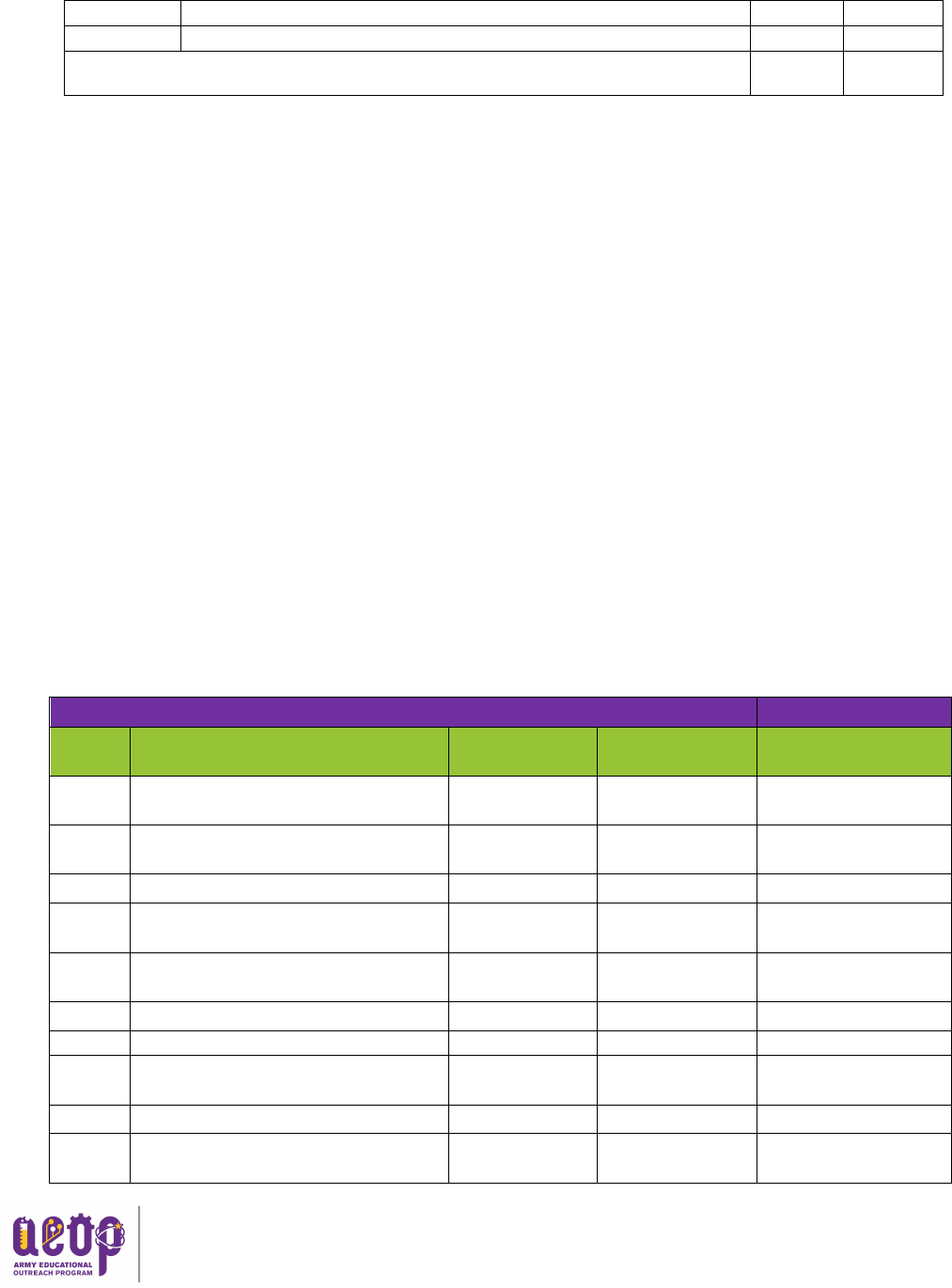
2017 Summative Evaluation Report | PART 1 Executive Summary | 4 |
Unite
Unite
358
402
URAP
Undergraduate Research Apprenticeship Program
59
49
Total 2016 AEOP Participants
32,947
8,714
In 2017 the AEOP portfolio included participation from various collaborating schools, laboratories,
Army/DoD S&E’s and other collaborating organizations. AEOPs involved participants from 3,476 K-12
schools (compared to 3,607 in FY16), including more than 1,333 Title I schools (an increase from 962 in
FY16). The portfolio of programs also involved 485 colleges/universities (a decrease from 568 in FY16),
including at least 92 HBCUs/MSIs (an increase from 69 in FY16). AEOP programs self-reported 77 Army
and DoD research and development laboratories or Army organizations involved in the work of the
programs. The AEOP worked with 77 Army-funded laboratories at colleges/universities (compared to 74
in FY16). There were 2,307 Army and DoD S&Es who participated in 2017 programming (compared to
1,287 in FY16).
Costs for the individual 2017 AEOP elements as well as the average cost per student for each program
element are detailed in the table below. Apprenticeship program costs ranged from $3,313 per apprentice
(REAP) to $8,186 per apprentice (CQL). The higher cost of CQL reflects the longer duration of the program,
which may take place in the summer or through portions of the academic year (sometimes lasting the
entire year). AEOP competitions ranged in cost from $140 per student (eCM) to $362 per student (JSHS).
GEMS, which is typically a 1-week summer STEM enrichment activity that takes place at Army laboratories,
had an average cost of $459 per student in 2017. While Unite, a 4-6-week summer STEM enrichment
activity for students from historically underserved and under-represented groups that takes place in an
existing University pre-collegiate program, had an average cost of $1,849 per student.
2017 AEOP Costs
Program Type
Program Cost
Cost Per
Participant
Average Stipend Per
Participant
CII
STEM Enrichment Program
(grades K-6)
$337,583
$237
NA
CQL
STEM Apprenticeship Program
(undergraduate/graduate)
$1,874,600
$8,186
$7,620
eCM
STEM Competition (grades 6-9)
$2,980,003
$140
NA
GEMS
STEM Enrichment Program (grades
5-12)
$1,306,404
$459
$311
HSAP
STEM Apprenticeship Program
(grades 9-12)
$230,961
$4,277
$3,044
JSHS
STEM Competition (grades 9-12)
$2,019,112
$362
NA
JSS
STEM Competition (grades 5-8)
$150,000
$168
NA
REAP
STEM Apprenticeship Program
(grades 9-12)
$390,924
$3,313
$2,127
RESET
STEM Educator Program
$141,661
$7,083
Varies by level
SEAP
STEM Apprenticeship Program
(grades 9-12)
$419,955
$3,717
$3,152
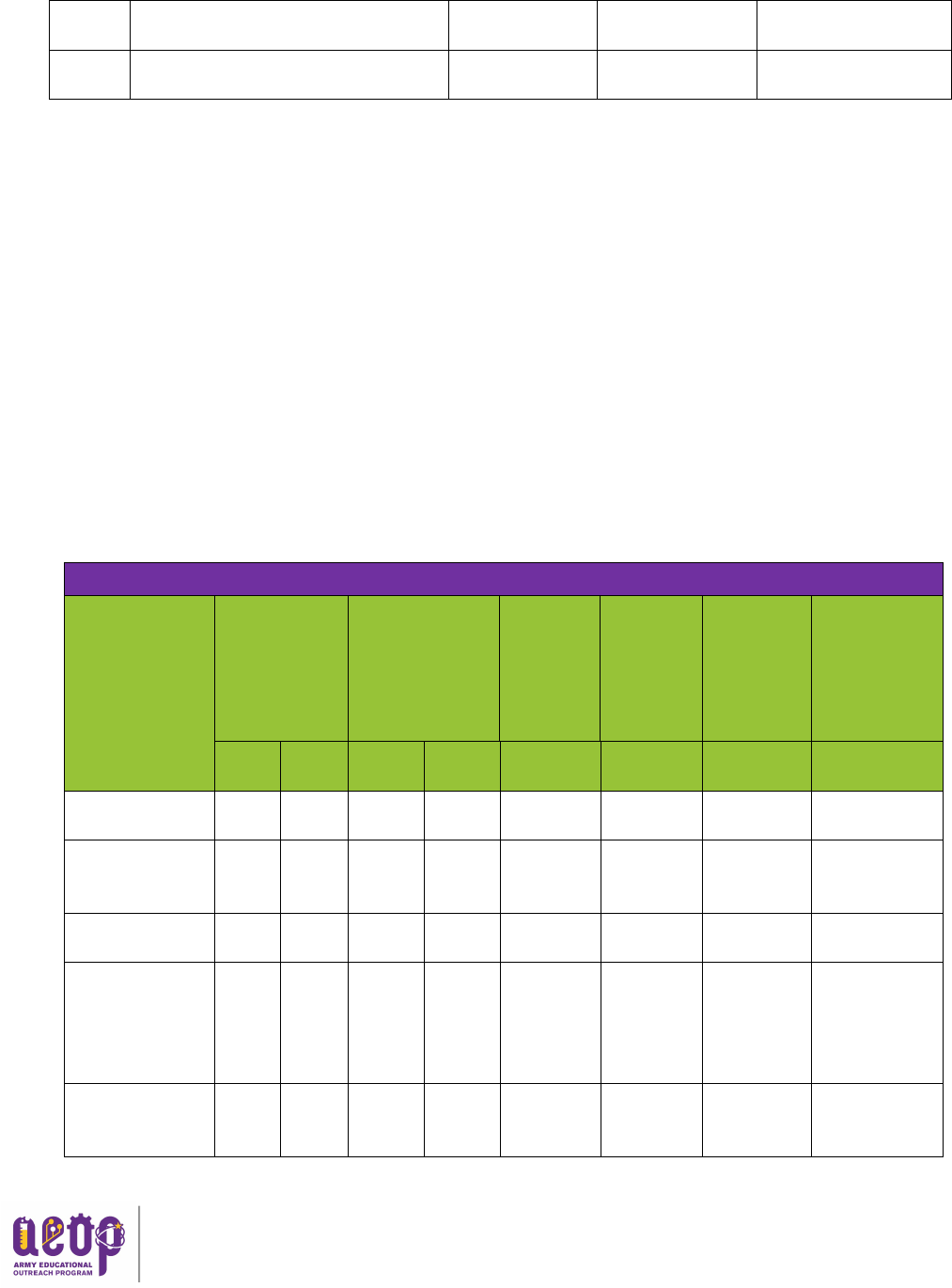
2017 Summative Evaluation Report | PART 1 Executive Summary | 5 |
As in previous years (FY14 to FY16), the apprenticeship programs had the highest cost per participant
while the competitions were the least costly of the AEOP elements on a per student basis for FY17. The
variation in costs between programs is largely due to the cost of participant stipends, which are dependent
upon the educational level of the student and duration of the program. Several programs appeared to be
more efficient in FY17 than in FY16 based upon their slightly lower cost per student participant in FY17
(CQL, eCM, JSS, Unite).
In regards to participation of the DoDEA and Army/DoD laboratories, there was a 26% increase in student
participation (855) compared to FY16 (679 students). Teacher participation decreased (FY17 40 teachers
compared to 57 in FY16) from DoDEA schools in the Pacific, Europe and the U.S. that participated in the
AEOP through the GEMS, eCM and JSHS program. Additionally, through the AEOP competition programs
(eCM, JSHS, JSS) and Unite, the AEOP engaged and collaborated with 242 organizations external to schools
and the Army and DoD laboratories (e.g., professional STEM organizations, businesses, Technology
Student Association state delegations, etc.).
Number of 2017 Collaborating Schools, Laboratories, Army/DoD S&Es, and Other Organizations
Program
K-12 Schools
Colleges/Unive
rsities
(represented
by participants
or serving as
host sites)
Army and
DoD
Research
Labs/
Army
Agencies
Army-
Funded
Universit
y Labs
Army and
DoD
Scientists
&
Engineers
(S&Es)
Other
Collaborating
Organization
s
Total
Title I
Total
HBCU/
MIs
Camp Invention
(CII)*
19
17
NA
NA
11
NA
NA
NA
College
Qualified
Leaders (CQL)
NA
NA
102
4
12
NA
206
NA
eCYBERMISSIO
N (eCM)
776
290
62
NA
46
NA
1,204
12
Gains in the
Education of
Mathematics
and Science
(GEMS)
924
315
74
3
15
NA
281
NA
High School
Apprenticeship
Program (HSAP)
54
15
36
20
NA
36
NA
NA
Unite
STEM Enrichment Program (grades
9-12)
$662,000
$1,849
NA
URAP
STEM Apprenticeship Program
(undergraduate)
$246,405
$4,176
$2,924

2017 Summative Evaluation Report | PART 1 Executive Summary | 6 |
Junior Science
and Humanities
Symposium
(JSHS)
1,024
378
112
11
37
NA
246
200
Junior Solar
Sprint (JSS)
312
92
NA
NA
NA
NA
37
3
Research and
Engineering
Apprenticeship
Program (REAP)
72
46
41
24
NA
NA
NA
NA
Research
Experiences for
STEM Educators
(RESET)
19
10
1
NA
3
NA
6
7
Science and
Engineering
Apprentice
Program (SEAP)
55
14
NA
NA
11
NA
119
NA
Unite
149
110
18
13
2
NA
38
20
University
Research
Apprenticeship
Program
(URAP)
NA
NA
39
17
NA
41
NA
NA
Total Sites
3,404
1,287
485
92
NA
NA
163
242
Data for the 2017 AEOP portfolio evaluation were collected and analyzed by Purdue University, the
evaluation arm of the Lead Organization (LO) of the AEOP CA, Battelle Memorial Institute. With the
support of the AEOP CA Consortium Members, Individual Program Administrators (IPAs), and Government
POCs, evaluation studies for the CQL, eCM, GEMS, HSAP, JSHS, JSS, REAP, RESET SEAP, Unite, and URAP
programs as well as an alumni evaluation were completed by the Purdue University team.
The FY17 AEOP program evaluation utilized participant questionnaires, 21
st
Century Skill Assessments, as
well as focus groups and/or interviews with participants and adults who led educational activities or
supervised research projects (herein called mentors). This report summarizes the 2017 evaluation of the
AEOP portfolio. Eleven individual program evaluation reports are available under separate cover.
Executive summaries for these eleven reports are attached as appendices to this document. This report
includes a program overview, evaluation and assessment strategy, study sample, and evaluation findings.
The final section offers evidence-based recommendations intended to inform decisions for future
program development.

2017 Summative Evaluation Report | PART 1 Executive Summary | 7 |
4 | Summary of Findings and Recommendations
The 2017 AEOP evaluation collected data about participants, their perceptions of program processes,
resources, and activities, and indicators of achievement related to outcomes aligned with AEOP, Federal
guidance and program objectives. A summary of findings and recommendations for FY18 are provided.
2017 Summary of Findings - Near Term
Priority 1: STEM Literate Citizenry
Broaden, deepen, and diversify the pool of STEM talent in support of our Defense Industry Base.
Finding #1
Growth in Overall Participation and Some Program Participation. In FY17, the AEOPs
increased participation overall 6%, from 30,972 in FY16 to a total of 32,947 participants in
STEM programs, STEM competitions, and STEM apprenticeship programs. This increase
reflects outcomes of increased investments in marketing and promoting AEOPs through a
variety of methods at local, state, and national levels and reverses a three-year downward
trend from enrollments of 41,802 in FY14, 38,039 in FY15, and 30,972 in FY16 respectively.
Programs that experienced participation increases in FY17 include: CII 17% growth (1,425
compared to 1,185 in FY16); eCM 3% growth (21,277 compared to 20,607 in FY16); GEMS
15% growth (2,845 compared to 2,427 in FY16); JSHS 5% growth (5,577 compared to 5,300
in FY16); JSS 34% growth (892 compared to 585 in FY16); Unite 21% growth (358 compared
to 282 in FY16); URAP 12% growth (59 compared to 52 in FY16). JSHS and JSS reversed a
downward trend in enrollment in FY17. It is important to note that in previous years, prior
to the implementation of the use of the Cvent online registration system, most of AEOP
program participation data were self-reported.
Finding #2
Decline in Participation for Most Apprenticeship Programs. Despite overall growth in
participation and some growth for programs mentioned in Finding #1, the remaining four
apprenticeship programs stayed the same or experienced a decline in participation for
FY17. CQL 3% decrease (229 compared to 236 in FY16); HSAP 17% decrease (54 compared
to 65 in FY16); REAP 2% decrease (118 compared to 120 in FY16); and SEAP stayed the same
at 113 for FY17 and FY16.
Finding #3
Three-Year High Number of Applications to Participate in AEOPs – However, Placement
Rates Declined in FY17 for some AEOPs. The overall placement rates across AEOPs
decreased from 83% from FY16 to 68% in FY17, despite a three-year high number of
applications submitted to participate in AEOPs. For FY17, there were 46,518 applications,
an increase of 20% over the 37,399 applications received in FY16 and a 4% increase over
the number of applications received in FY15 when 44,632 applications were received. As a
result of the increasing number of applications, apprenticeship programs have
experienced a downward trend in placement rates due to limitations in funding and
availability of placements/mentors. CQL placed 41% of applicants in FY17, as compared to
51% in FY16; HSAP placed 9% of applicants in FY17 as compared to 18% in FY16; REAP
placed 17% of applicants as compared to 25% in FY16; URAP placed 9% of applicants in
4
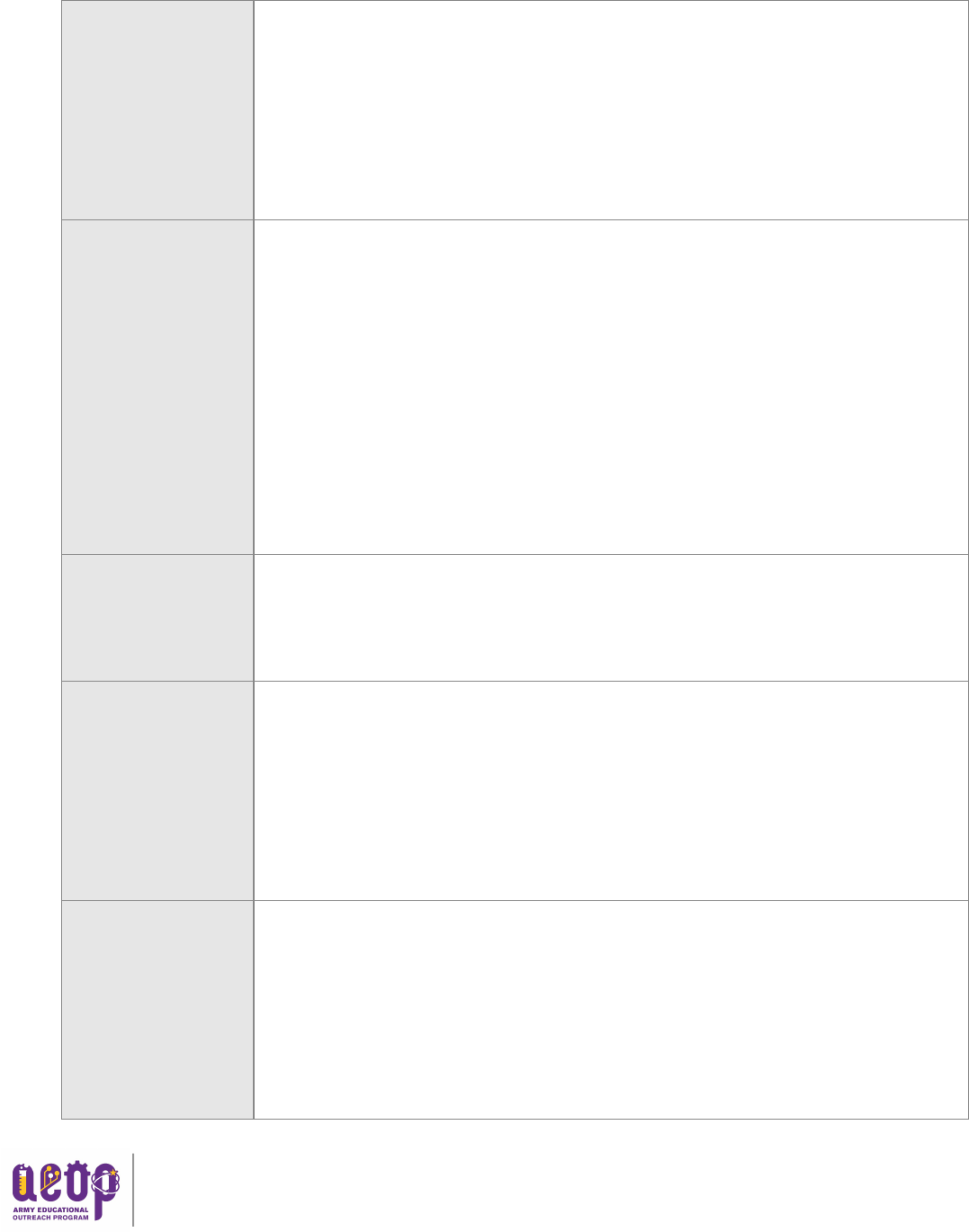
2017 Summative Evaluation Report | PART 1 Executive Summary | 8 |
FY17 as compared to 29% in FY16; and SEAP placed 13% of applicants as compared to 16%
in FY16. However, placement rates grew slightly for STEM enrichment activities. GEMS
placement increased from 55% in FY16 to 61% in FY17 and Unite enrollment grew from
41% in FY16 to 45% in FY17. Acceptance rates for STEM enrichment programs increased
in FY17 (61% GEMS, 38% Unite) as compared to FY16 when 55% of GEMS applicants and
41% of Unite applicants were selected for these programs. eCM continued to accept all
applicants in FY17 to participate in the program, as in previous years. The JSHS
competition does have restricted participation due to regional capacities. However, JSHS
increased placements to 65% in FY17 compared to 60% in FY16.
Finding #4
AEOPs Continued to Serve Underserved Populations. The AEOPs continued to prioritize
the participation of students from traditionally underserved groups, per the AEOP
definition: AEOP’s definition of underserved includes at least two of the following: low-
income students; students belonging to race and ethnic minorities that are historically
underrepresented in STEM; students with disabilities; students with English as a second
language; first-generation college students; students in rural, frontier, or other federally
targeted outreach schools; females in certain STEM fields.
As reported by AEOPs, apprenticeship programs included 38% of underserved students in
their total population. CII achieved 100%, while Unite registered 65% and REAP 54%
respectively. The next highest enrollment of underserved students was eCM with 45%.
GEMS and JSS both had 29% participation of underserved students. All remaining programs
had 19% or less underserved participation – with CQL and SEAP having the lowest
percentages at 6%. Others included: HSAP (19%); JSHS (19%); and URAP (8%).
Finding #5
Participants reported engaging in STEM practices significantly more in their AEOP
programs as compared to in their typical school experiences for each program. Evaluation
findings indicated that AEOPs consistently provided opportunities for participants to
engage in authentic STEM activities that are significantly more intensive than those they
experience in their typical school settings.
Finding #6
Participants reported increased STEM competencies, STEM skills, STEM knowledge, STEM
practices, and confidence in STEM after participating in AEOPs. The programs with the
highest level of agreement (some gain to large gain) with growth in 21
st
Century STEM Skills;
STEM Knowledge; and STEM practices after participation included: CQL, eCM, GEMS, HSAP,
JSHS, REAP, SEAP, Unite, and URAP. Participants from all programs indicated some to a large
gain in their STEM identity after participation. Participants from CQL, eCM NJ&EE, GEMS,
HSAP, REAP, SEAP, Unite, and URAP reported 90% or higher agreement with the statement
“I am more confident in my STEM knowledge, skills, and abilities” after participating in the
AEOPs.
Finding #7
Participants demonstrated increased attainment toward mastery of the 21
st
Century
Skills across their participation in the AEOPs in the FY17 pilot of the assessment.
Participants from apprenticeship programs (REAP, URAP, HSAP) and STEM enrichment
program Unite demonstrated growth in all areas of the 21
st
Century Skills Assessment from
baseline (first days of program) to end of program. Participants exhibited growth in
Creativity & Innovation; Critical Thinking & Problem Solving; Communication,
Collaboration, and Social and Cross-Cultural Skills; Information, Media, & Technological
Literacy; Flexibility, Adaptability, Initiative, & Self-Direction; Productivity, Accountability,
Leadership, & Responsibility.
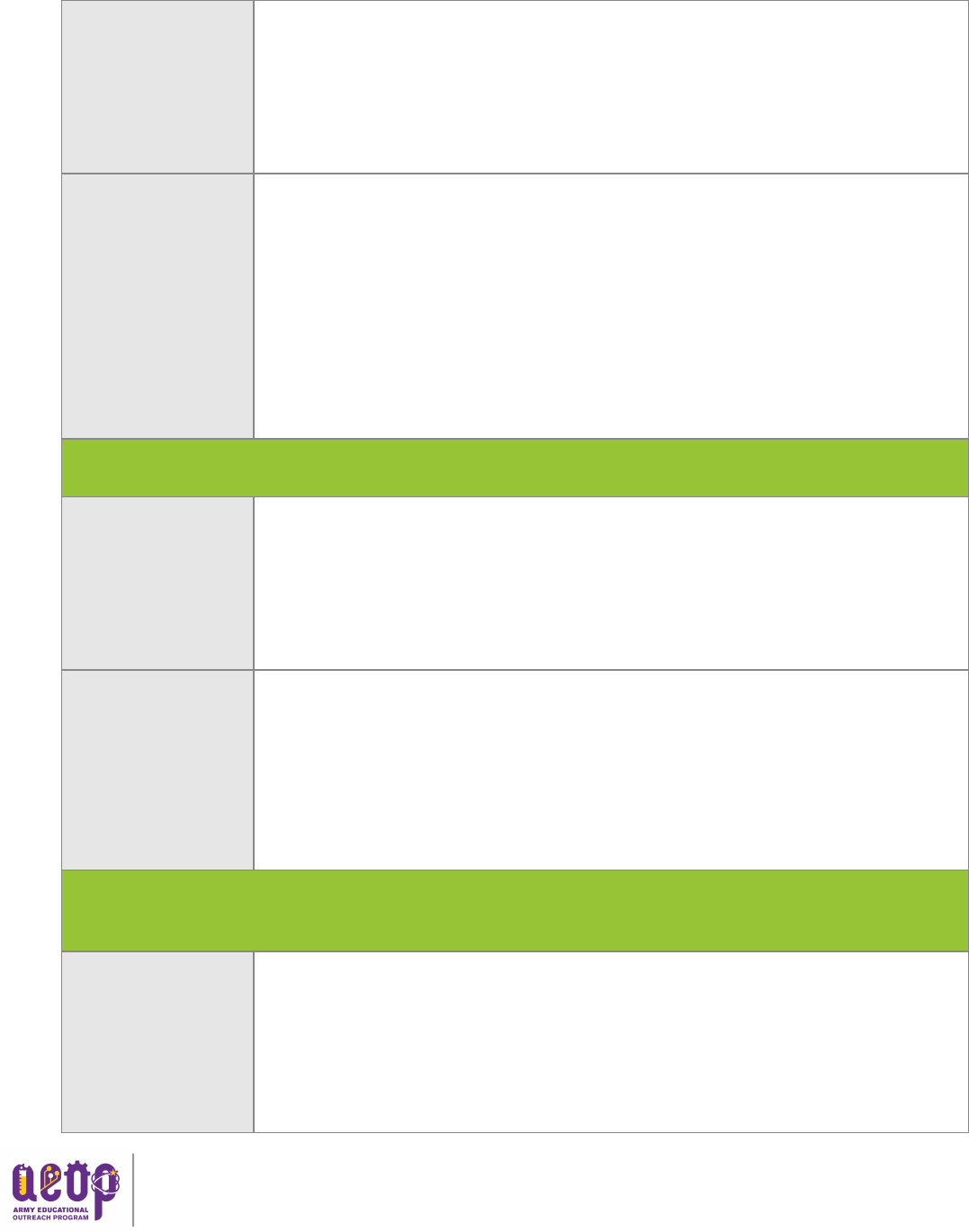
2017 Summative Evaluation Report | PART 1 Executive Summary | 9 |
Finding #8
Participants reported positive attitudes toward Army/DoD STEM Research. AEOP
participants in CQL, eCM NJ&EE, GEMS, HSAP, REAP, SEAP, Unite, and URAP reported 75%
or more agreement with the statements: “DoD researchers advance science and
engineering fields”, “DoD researchers develop new cutting-edge technologies”, “DoD
researchers solve real-world problems”, and “DoD research is valuable to society”.
Programs that reported less than 75% agreement with the statements included JSHS, JSS,
and eCM (regional).
Finding #9
Evaluation findings indicated that the AEOP exposed participants to STEM careers
generally and to Army and DoD STEM careers, and participating in AEOPs increased their
interest in pursuing STEM careers. A majority of participants (range of 53%-97%) in CQL,
eCM National, GEMS, HSAP, JSHS, REAP, SEAP, and Unite reported learning about 3 or more
STEM careers. Fewer students (range of 32%-44%) in eCM Regional, JSS, and URAP had
learned about 3 or more STEM careers. In regards to specific DoD STEM Careers,
participants reported less exposure in FY17 AEOPs than to STEM careers overall. However,
a majority of students (range of 64%-84%) in all programs except for eCM Regional (39%)
were more interested in pursuing STEM careers after their AEOP participation and more
than half of responding apprentices reported interest in DoD STEM careers in FY17 (range
of 66%-87%).
Priority 2: STEM Savvy Educators
Support and empower educators with unique Army research and technology resources.
Finding #1
Adult participants (i.e. mentors, S&E’s, Team Advisors, teachers) reported use of effective
mentoring strategies in varying degrees across the AEOPs in FY17. Strategies to engage
students in authentic STEM activities (range of 82%-94%) were used most frequently, while
strategies to support participants STEM educational and career pathways (range of 47%-
69%) were used the least. A majority of all adults (range of 63%-86%) reported using
strategies to support the needs of diverse students as learners. Further, a large majority of
adults (82%-94%) reported the use of authentic STEM activities.
Finding #2
In FY17, participants continued to be satisfied with the support received from their
mentor/S&E/Team Advisor/teacher. Most apprentices and students in all programs
reported high levels of satisfaction with the mentorship they received and the quality of
instruction they received (range of 62%-84%). The levels of satisfaction for several
programs, CQL, GEMS, REAP, SEAP, and Unite, were somewhat lower than those reported
in FY16, however levels satisfaction in HSAP and URAP were higher than in FY16. Overall,
the percentage of satisfaction with instruction or mentorship in FY17 was very similar to
that reported in FY16 (range of 62%-83%).
Priority 3: Sustainable Infrastructure
Develop and implement a cohesive, coordinated, and sustainable STEM education outreach infrastructure across the
Army.
Finding #1
The primary means of learning about AEOPs and associated opportunities in FY17
continues to be personal connections, school/university connections, past participants,
or someone connected directly with AEOPs. A continued strength of AEOP is the expansive
network of connections to local communities that serves as a continued means of
recruitment for the program. Overwhelmingly, participants and mentors reported that
AEOP social media, AEOP website, and other materials were much less frequently used as
a means for introducing them to the program.

2017 Summative Evaluation Report | PART 1 Executive Summary | 10 |
Finding #2
Despite limited awareness of participants and mentors of the full AEOP and DoD/Army
portfolio of opportunities, FY17 participants reported interest in continuing on to
participate in another AEOP in the future. Some individual programs made progress in
FY17 in increasing awareness of AEOP programs overall. However, participants in some
programs were not aware of other opportunities within AEOP.
Finding #3
Participation in the AEOP evaluation in FY17 improved for apprentices/students in most
programs. Mentor/adult questionnaire completion is still less than desired. Programs
including CQL, eCM NJ&EE, GEMS, HSAP, REAP, SEAP, URAP, Unite all improved
apprentice/student participation in FY17 – reaching 46% to 94% response rate. Mentors
from HSAP, REAP, and URAP also achieved acceptable return rates.
2017 Summary of Findings - Mid to Long Term
Priority 1: STEM Literate Citizenry
Broaden, deepen, and diversify the pool of STEM talent in support of our Defense Industry Base.
Finding #1
AEOP alumni indicated interest in pursuing a STEM degree and career. A majority of
alumni participating in the survey indicated they were both interested in earning a STEM
degree (88%) and pursuing a STEM career (88%).
Finding #2
Alumni are interested in completing additional elective STEM courses and other STEM
opportunities. More than three-quarters of alumni reported interest in taking elective
STEM courses (80%), learning about new things in STEM (83%), and potential STEM
projects/experiments in a university or professional setting (87%).
Finding #3
AEOP Alumni continue to be engaged in STEM. Nearly three-quarters or more of alumni
reported sometimes or frequently engaging in activities such as: learning about new
things in STEM (88%), talking with family and friends about STEM (75%), and solving
math/science puzzles (73%).
Finding #4
Alumni hold positive views toward STEM generally and Army/DoD STEM specifically. Over
80% of AEOP alumni believe that all people can be successful in STEM. Alumni report
agreement with the following statements: I enjoy solving real-world problems (97%); STEM
careers are a good fit with my interests (97%), I feel successful in STEM classes (95%), and I
can use STEM to help improve my community (95%). In regards to Army/DoD STEM attitudes
specifically, 95% percent or more of alumni indicated feeling Army/DoD research is valuable
to society, 97% agree that the Army/DoD solves real-world problems, as well as develops
new, cutting edge technologies.
Finding #5
Alumni report interest in STEM careers generally, as well as with the Army/DoD
specifically. Nearly all alumni reported being interested in pursuing a STEM career (93%)
in general. Three-quarters indicated they were aware of Army/DoD STEM careers (75%),
and 82% of alumni indicated they would be interested in learning more about Army/DoD
STEM careers. Approximately two-thirds (64%) of alumni were interested in pursuing an
Army/DoD STEM career at the present time.
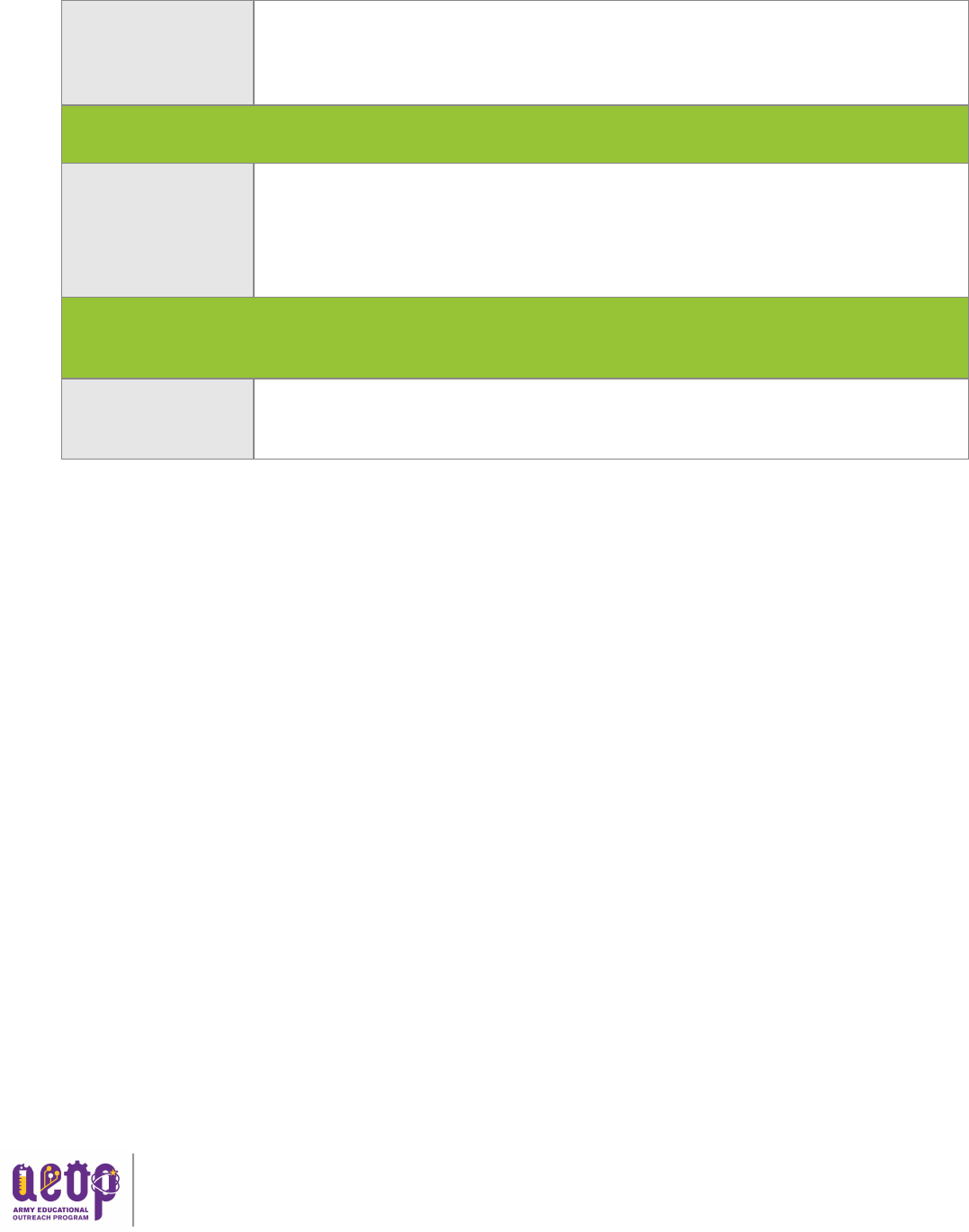
2017 Summative Evaluation Report | PART 1 Executive Summary | 11 |
What AEOP Participants are saying…..
“I have had a fantastic experience [in CQL]. I owe a lot to my mentors who guided me every step of the way.
Thanks to them, I have had the opportunity of publishing scientific articles, giving talks at conferences, and
performing cutting edge research. I recently was accepted into graduate school for Ph.D. studies and I believe
a major part of my acceptance was the experience I gained from this program.” --CQL Apprentice
“[CQL] provides full immersion of students into nonacademic labs to gain further experience in STEM
programs to understand other available professional paths. It is an excellent summer program and I wish I
had participated when I was in college.” --CQL Mentor
“I never really thought of pursuing STEM because it seemed like a job where you had to sit behind a desk and
type on a computer…After doing eCM and talking to the Army officers and everyone, it makes it seem like
there are so many more opportunities.” --eCM-NJ&EE Student
“I think the [eCM] program is so well organized and it’s got so many resources that I can get a group of sixth
grader to stick with a topic and work on a project for almost an entire year… it’s very open-ended and they
get to pick a topic. It’s part of their community. They feel that direct connection. They take ownership for
what they’re doing. They become experts in what they’re doing. They develop patience. They’re collaborating.
They’re managing time. Their developing all of these skills, I think, is invaluable.” --eCM Adult Participant
“[In GEMS], you get to meet people who do the jobs and hear their side of the story about what the [jobs
are like] that you may be considering going in to.” --GEMS Student
Finding #6
35% of AEOP Alumni reported enrollment in a STEM degree program. Engineering was the
highest enrolled field (11%), followed by medicine (7%), life science (6%), physical science
(5%), mathematics or statistics and technology or computer science (2% each respectively),
followed by Earth science and business (1% each respectively) and other 4%.
Priority 2: STEM Savvy Educators
Support and empower educators with unique Army research and technology resources.
Finding #1
Participants reported very positive impacts of their mentors and agreed mentoring is a
valuable aspect of AEOPs. Many alumni also believed their AEOP mentor helped influence
their future academic career decisions (83%), and helped them learn about Army/DoD
careers (78%). While the reported mentoring relationships appeared to be strong, nearly
half indicated they have stayed in touch with their AEOP mentor after the program (43%).
Priority 3: Sustainable Infrastructure
Develop and implement a cohesive, coordinated, and sustainable STEM education outreach infrastructure across the
Army.
Finding #1
Alumni reported strong interest in participating in other AEOPs, though less than 60%
indicated they were familiar with other AEOPs. In fact, 80% of alumni who responded to
the mid to long term evaluation questionnaire indicated interest in future participation.

2017 Summative Evaluation Report | PART 1 Executive Summary | 12 |
“[GEMS] kids are able to learn principles and apply them immediately, as opposed to the typical classroom
setting where they would learn something but not get the direct application. They’re able to conceptualize
how it would happen in the real world as well as what skill sets they could use in a career” --GEMS Mentor
“I am very impressed by every single hard-working researcher in our group. Each of them contributed to my
learning experience and were always willing to address any questions I had. I am especially thankful for my
mentor, who worked closely with every day and helped me discover all the theories behind our optical
pressure sensor research project. He ensured that I always had the opportunity to involve myself in cutting-
edge research and allowed me to make the most of my HSAP experience. I was exposed to areas of the
engineering world, such as resonances, semiconductor fabrication process, and so much more, that I never
knew existed. I am endlessly grateful for AEOP for this eye-opening opportunity, and I am confident that this
experience will lead me to unimaginable paths and direct my future for the better.” --HSAP Apprentice
“I am very happy with the three excellent HSAP students worked in my lab not only for the work they have
done (two manuscripts in preparation with them as co-authors), but also their passions and hard works in
learning. I could see the changes in them within this short 8 weeks of lab experience and all three will pursue
STEM in college (Physics, Engineering and pre-med).” --HSAP Mentor
“I realized how much I love my research project and understanding how the universe [works], so I've decided
to go into theoretical physics instead of computer science. I changed my mind after being inspired by the
Nobel Laureate and speaking with JSHS alumni on Saturday morning.” --N-JSHS Student
“JSHS is a wonderful competition and symposium. It is worthwhile for all students that participate; regardless
if chosen to present or move on to national level.” --JSHS Mentor
“I am very pleased with my JSS experience. It taught me so many things and made me confident in
complicated scenarios. All of the people I met and my mentors helped me out so much. I loved my experience
and had a great time.” --JSS National Student
“For [students in JSS] to have an opportunity to go and do something – fail at it, do well at it, or whatever –
and then be pushed the next year to learn from those experiences, that is what life is all about.” --JSS Mentor
“I am extremely satisfied with [REAP]. I have learned a lot in very little time, and the program has definitely
increased my interest in STEM! I also appreciate and respect the inclusion of minority groups in STEM. As a
Hispanic woman, I know my demographic is vastly underrepresented in STEM careers, and it is very important
that we change that. I very much enjoy being a part of this program and definitely will apply again next year.
Thank you so much for allowing me to participate; REAP has definitely changed my life for the better!” --REAP
Apprentice
“The [REAP] students were all brilliant, and we grew as a group over the summer. The students furthered my
interest in research by helping me understand problems from different points of view.” --REAP Mentor
“My [SEAP] mentor was very helpful throughout the entire process and worked with me through every step.
He helped me understand science concepts relating to my project and taught me various lab skills. Overall, the
program was very beneficial and has allowed me to expand my knowledge in the areas relating to the STEM
field.” --SEAP Apprentice

2017 Summative Evaluation Report | PART 1 Executive Summary | 13 |
“The SEAP program was simple and provided a great opportunity for the student to learn more about
Engineering and research prior to beginning a degree program in Mechanical Engineering. As a PhD
researcher in engineering, I wish I had been afforded a similar opportunity. The program is a great way for
the Army and ERDC to market ourselves to the community, gain summer help from eager students, and
continue to build a pool of recruits for the future.” --SEAP Mentor
“I loved [Unite]. It was the perfect mix of learning and fun. Also, it was amazing to meet so many people also
interested in similar topics. Over all it has helped me narrow down my career choices as it showed me what
interests and skills I have in various forms of engineering.” --Unite Student
“This year my Unite experience was excellent! The curriculum that was designed strongly supported the goals
of the program and there was clear growth and development in the participants from the beginning of the
program to the end of the program. We incorporated several enrichment components that allowed students
to explore their creativity, build teamwork and effective communication skills, improve their math and
problem-solving abilities, and gain valuable knowledge about STEM careers.” --Unite Mentor
“The [URAP] apprenticeship program was one of the most inspiring and challenging experiences I have had as
an engineering student. It will help me to grow as a Mechanical Engineer and also to be a scientist. I learned
that we should not be afraid to be wrong during experiments. Not only is knowledge important, but patience,
imagination, and creativity are important, too. I would love to be in a program like this again.” --URAP
Apprentice
“[URAP] is very beneficial for undergraduate students interesting in exploring STEM research. This also gives
them a chance to think and work independently, as well as in collaboration with other researchers, thereby
preparing them for a future career in STEM research.” --URAP Mentor
Recommendations for FY18 Program Improvement/Growth
While the successes for AEOP detailed above are commendable, there are some areas that remain with
potential for growth and/or improvement. The evaluation team therefore offers the following
recommendations for FY18 and beyond.
AEOP Priority: Broaden, deepen, and diversify the pool of STEM talent in support of our Defense
Industry Base
Increase and broaden participation in selected AEOP programs. In FY17, AEOP experienced a 6% growth
in participation, increasing to nearly 33,000 participants. The positive momentum should be catalyzed
moving in to FY18. It is recommended that additional resources and efforts be expended in regards to
eCM and JSHS specifically. Both of these programs produced growth in participation this year. eCM has
the flexibility within the e-model to grow participation relatively easily. JSHS has large (~3,000 applications
in Cvent alone in FY17) unmet need that could be transformed into additional participation if
infrastructure is in place to accommodate more participants. This is likely just a percentage of the actual
number of applications, as only 72% of the overall total JSHS regions used Cvent for registration in FY17.
Cvent captured only 2,435 of the 5,577 students reported. It is suggested that these programs examine

2017 Summative Evaluation Report | PART 1 Executive Summary | 14 |
strategies that programs such as Unite and JSS have used to produce growth in FY17 (over 20%). AEOPs
should continue to work to grow the percentage and number of underserved students who are
participating in the program. Unite, REAP and JSS can serve as potential models for the consortium of how
to achieve this in a more rapid and impactful manner.
Examine means for increasing infrastructure to grow placement rates in JSHS and apprenticeship
programs. An important first step in examining strategies to increase enrollment for AEOP overall may be
to take a look at the current unmet need and demand for programs within the portfolio that may not have
the infrastructure (personnel and resources) to be able to accommodate additional participants. Any
potential resources that may be redirected in the way of these programs, or from other potential future
proceeds, could be used to translate into increased participation in FY18.
Strengthen programs ability to impact STEM outcomes and awareness of DoD/AEOP. In FY17, most
programs had significant impacts on STEM outcomes and awareness for participants. Two of the AEOPs
that did not produce as large of gains as the others were JSS and eCM NJ&EE. It is recommended that the
AEOP examine the format, delivery, and feedback from these programs in partnership with the other
partners to determine how there could be improvement in this area in FY18 and beyond.
Continue to examine impact of AEOP participation on growth in skills beyond self-reports. The FY17
pilot of the 21
st
Century Skills Assessment has provided a powerful glimpse into the significant impact that
AEOP participation is having on extended-time programs (more than one-week in duration) including
some of the apprenticeship programs and Unite. In FY18, the AEOP should continue to build upon this
pilot to consider ways to implement a similar measure with other programs that have more sporadic or
intermittent (not multiple-day) frequency. True independently assessed growth (not self-reported by the
participant) in skills provides a more accurate measure of impact on skills and knowledge than self-
reporting. However, self-reports (questionnaires) also serve as a data point that reveals participants
attitudinal and interest data as well as their perceptions of growth in skills and knowledge.
AEOP Priority: Support and empower educators with unique Army research and technology
resources
Continue to focus on strengthening role of adults in mentoring and instruction. In FY17, there was
considerable improvement in the support of mentor use of effective mentoring strategies within and
across AEOPs, in part due to increased focus and investment of AEOP to the findings of the FY16
evaluation. However, there is still room for more growth, as reported use of effective strategies still
remains less than 50% for some programs and strategy areas. This is an area that should continue to be a
key component of the continued efforts to provide more resources, onboarding, and potential mentoring
(of mentors) to continue to make even greater impacts on student desired outcomes of the AEOP.
Grow adult and youth participant awareness through support and innovative programming from
AEOPs. An area of concern that was prevalent across the majority of AEOPs in FY17 was the persistence
of lack of information availability and/or utilization regarding AEOPs, as well as Army/DoD opportunities
and information by mentors and/or adults leading programs. While we are cognizant of the increased

2017 Summative Evaluation Report | PART 1 Executive Summary | 15 |
focus this area has received over the past couple of years, it appears that mentors need more support
and/or resources/programming/speakers/etc. to provide to students in multiple modes so that
participants become more deeply aware of AEOPs, and Army/DoD opportunities. It is recommended that
the AEOP examine best-in-class practices such as what eCM NJ&EE uses and consider scaling-up effective
strategies across the consortium.
AEOP Priority: Develop and implement a cohesive, coordinated, and sustainable STEM education
outreach infrastructure across the Army
Expand reach of AEOP marketing, recruitment strategies beyond current local networks. Over the past
three years of the AEOP evaluation, it has become increasingly clear that the portfolio has a vibrant, grass-
roots network that has served the AEOP very well in the past and currently. It is important to note how
difficult it often is to get deeply rooted within local contexts and communities to be able to produce such
powerful networking and recruitment efforts year after year. However, it is the time to look to go beyond
these networks to reach out to tap underserved populations that have little to no awareness of the
outstanding opportunities that await them within the AEOP. This is not to say that the current AEOP
network be disregarded – it should continue to be nurtured and leveraged. It is recommended that the
consortium work to develop, at a minimum, a targeted plan for outreach and participation for FY18. The
consortium began this work with the integration of Strategic Outreach Partners in FY16 and continued in
FY17. To date 15 organizations have received funding to work with the AEOP to broaden participation
through outreach to underserved communities. Additionally, in FY17 eCM awarded mini-grants to 183
team advisors to support participation in the program. Nearly 100 of those awards were to teachers at
Title One schools. Potentially some of the strategic partners should be filling this role to help expand the
reach of AEOP.
